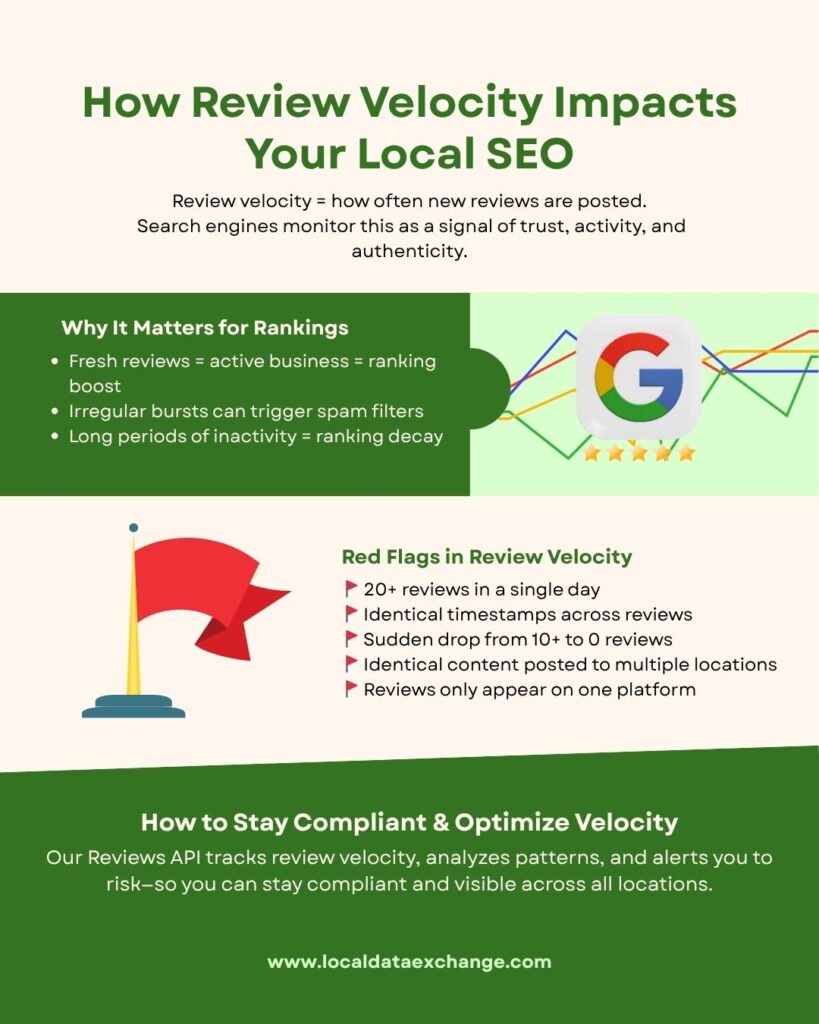In local SEO, most SaaS providers understand the value of ratings, keywords, and sentiment in online reviews. But there’s another factor that often goes unnoticed: review velocity.
Review velocity refers to the pace and frequency at which a business receives reviews over time. Google, Yelp, and other platforms analyze this metric to detect momentum, identify engagement trends, and flag potential spam.
For SaaS platforms managing multi-location businesses, understanding and optimizing review velocity is critical, not only for improving visibility in local rankings, but also for staying compliant with algorithmic trust standards.
What Is Review Velocity?
Review velocity is the rate at which new reviews are posted. It’s typically measured over time: daily, weekly, or monthly depending on platform policies and ranking models.
A steady stream of authentic reviews signals:
- Active customer engagement
- Ongoing business operations
- A consistent user experience
Conversely, erratic bursts or sudden drop-offs in review activity can hurt rankings or trigger fraud detection.
Why Review Velocity Matters for Local Rankings
Google’s local algorithm looks for indicators of trust and relevance. One of those indicators is freshness of user engagement, with reviews acting as a proxy for real-world customer experiences.
Key reasons why review velocity influences ranking:
- Fresh Signals for the Algorithm
Consistent review activity tells Google a business is still active, trusted, and frequently interacted with. Listings with stale review histories often drop in visibility. - Relevance in the Local Pack
If two businesses have similar profiles, Google may prioritize the one receiving new reviews. It signals ongoing customer validation and relevance. - Fraud and Spam Detection
Google detects and penalizes suspicious velocity patterns—such as receiving 20 reviews in a single day after months of silence. Irregular spikes often suggest fake reviews or incentivized tactics. - Improved Keyword Footprint
The more frequent the reviews, the more likely new keywords (like services, products, or city names) will appear in the text—boosting SEO relevance and discoverability.
Normal vs. Suspicious Review Velocity
For SaaS platforms serving multi-location brands, velocity norms vary by industry. For example:
- Restaurants or salons may see 10–20 reviews per month.
- Financial institutions or legal firms may get only 1–2.
- Retail chains often experience seasonal fluctuations.
Suspicious patterns include:
- 20+ reviews posted within a few hours
- Sudden drop to zero reviews after regular weekly activity
- Reviews posted in patterns (e.g., always on Mondays at 10 a.m.)
Such anomalies can trigger platform audits or visibility penalties.
Review Velocity Benchmarks for SaaS Platforms
When managing review acquisition at scale, here are safe velocity benchmarks per location:
| Industry | Safe Monthly Velocity |
| Restaurants / Food | 10–30 reviews |
| Healthcare | 5–10 reviews |
| Automotive | 5–20 reviews |
| Retail / CPG | 5–15 reviews |
| Fitness / Wellness | 4–8 reviews |
These aren’t hard limits, but maintaining organic and consistent pacing across each location is key.
How SaaS Providers Can Influence Review Velocity Safely
To stay within platform guidelines while still driving growth, use these strategies:
1. Distributed Requests
Automate requests evenly across the customer lifecycle (e.g., post-service, delivery, or checkout) to avoid spikes.
2. Personalized Timing
Trigger review prompts based on user behavior, such as:
- Time spent on site
- Repeat purchase
- Survey completion
This avoids bulk timing and encourages better pacing.
3. Cross-Platform Strategy
Don’t concentrate efforts on a single platform. Balance reviews across Google, Yelp, Facebook, and industry-specific sites.
4. Review Buffering
Use platform features (or your own delay logic) to space out review submissions if customer behavior shows burst patterns (e.g., events or product launches).
5. Location-Specific Goals
Each location should have a tailored velocity goal based on foot traffic, online orders, or local marketing campaigns.
How to Monitor Review Velocity
If your SaaS platform isn’t already tracking review velocity programmatically, here’s what to do:
a. Ingest Reviews via API
Use review APIs to fetch all reviews across platforms, per location.
b. Timestamp Indexing
Index all review timestamps and store in a structured database.
c. Velocity Scoring
Calculate daily/weekly velocity and compare to baseline expectations.
d. Flagging System
Trigger alerts for locations with:
- Sudden review spikes
- Unusual droughts
- Cross-location copy/paste patterns
These can then be reviewed by automated rules or human moderators.

How Our Reviews API Handles Review Velocity
Local Data Exchange’s Business Reviews API is built to track and analyze review velocity across locations, platforms, and brands. We offer:
- Timestamps and source for every review
- Aggregated velocity metrics over time
- Sentiment and keyword tagging to analyze bursts
- API hooks to trigger notifications when suspicious patterns emerge
This makes it easy for SaaS providers to enforce safe practices, optimize local rankings, and keep clients’ reputations clean.
Review velocity isn’t a vanity metric. It’s a critical signal that shapes local ranking, affects visibility, and guides platform trust algorithms. SaaS marketing platforms that ignore velocity risk mismanaging their clients’ presence—while those who master it gain a measurable advantage.
By understanding, tracking, and optimizing velocity across hundreds or thousands of locations, you ensure steady, compliant growth in reputation and search visibility.
Ready to monitor and optimize review velocity for every location you manage?
Our Reviews API gives you the tools to track pacing, detect anomalies, and ensure consistent engagement—at scale.📈


